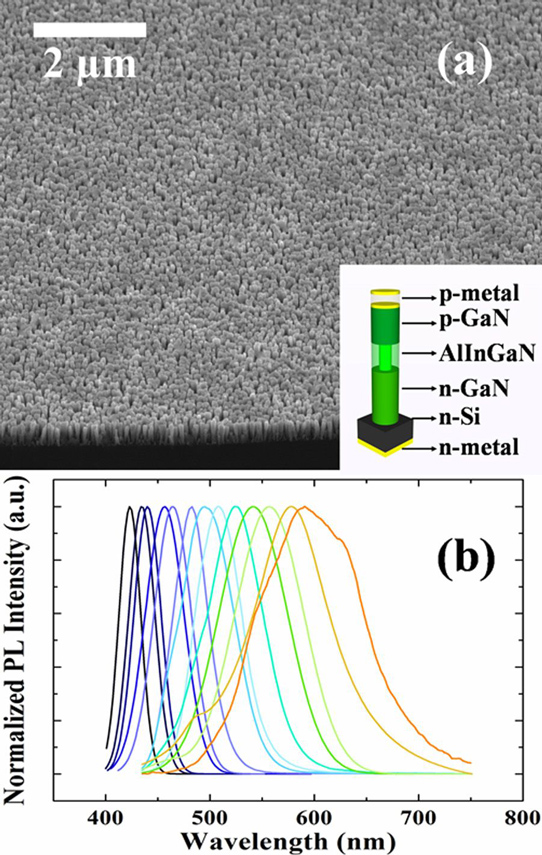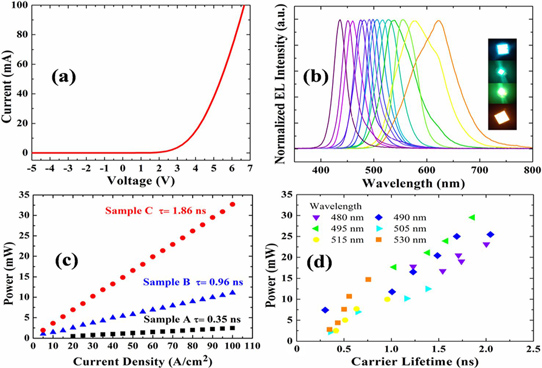- News
22 July 2015
Aluminium indium gallium nitride nanowire LEDs on silicon
McGill University in Canada has developed light-emitting diodes based on aluminium indium gallium nitride (AlInGaN) nanowires on silicon with spontaneous core-shell structures that inhibit non-radiative surface recombination, improving efficiency, across a wide range of visible wavelengths from blue-green to red [Renjie Wang et al, Appl. Phys. Lett., vol106, p261104, 2015].

Figure 1: (a) Scanning electron micrograph of AlInGaN core-shell nanowire arrays grown on Si substrate. Inset: schematic of nanowire LED. (b) Normalized photo-luminescence spectra of AlInGaN core-shell nanowires under different growth conditions.
The vertical nanowire structures (Figure 1) were created on silicon (111) substrates using radio-frequency plasma-assisted molecular beam epitaxy (PAMBE) in a nitrogen-rich environment. The 70nm AlInGaN core-shell active region was sandwiched between 200nm of silicon-doped n-GaN and 150nm magnesium-doped p-GaN.
The n- and p-GaN contact regions were grown at 770°C. The temperature of the active-region growth was between 610°C and 700°C. The Ga beam equivalent pressure during the active-region growth was 4.5x10-8Torr. The In and Al pressures were varied – between 1.2x10-7 and 2.6x10-7 Torr and between 1.7x10-9 and 1.3x10-8 Torr, respectively.
The varying growth conditions enabled photoluminescence peaks between 410nm and 630nm – a fair proportion (~70%) of the visible spectrum of 390-700nm. Three samples with wavelengths in the blue-green range 495-515nm were chosen for closer study (Table 1). The core-shell structure was found to increase carrier lifetimes, compared with InGaN nanowires (0.2ns). The short lifetime in InGaN nanowires without any Al is related to surface recombination.
Table 1: Growth conditions and characterization results for representative AlInGaN segments.
| Sample | BEPAl (x10-9 Torr) | BEPIn (x10-7 Torr) | Tsample (°C) | Wavelength (nm) |
τ (ns) |
| A | 3.54 | 1.25 | 625 | 515 | 0.35 |
| B | 5.70 | 1.38 | 635 | 515 | 0.96 |
| C | 10.7 | 2.06 | 670 | 495 | 1.86 |
Elemental studies using various probes showed the AlInGaN region of sample C to consist spontaneously of an indium-rich core and an 18.5nm-thick predominantly AlGaN shell. Similar results were found for the other samples. The AlGaN shell provides a barrier against carrier migration to surface recombination states.
The researchers explain the spontaneous formation of the core-shell structure as being due to different diffusion and desorption properties of indium, gallium and aluminium. Indium in particular desorbs more easily than the other species of atom. "The desorbed In atoms cannot be immediately compensated by impingent atoms, due to the shadowing effect of neighboring nanowires," the researchers write. These balance of these properties are also dependent on temperature.
The thickness of the AlGaN shell correlated with lifetime. Sample A with a low Al flux had a thin shell and corresponding short lifetime. Sample B had a thicker shell, thanks to the higher Al flux (~13nm), and a longer lifetime.
The researchers add: "It is also worthwhile mentioning some additional advantages of the AlInGaN core-shell nanowire LEDs. The incorporation of Al in the active region can effectively reduce the strain and the associated defect formation. Moreover, the use of relatively thick active regions (70nm) can significantly reduce the carrier density under high-power operation, thereby minimizing non-radiative Auger recombination and hot-carrier effect under high-power operation."
The nanowire material was used to fabricate square LED chips with sides between 0.3mm and 1mm. Contacts were formed on the p-GaN and the back-side of the silicon substrate. The chips emitted at wavelengths between 430nm and 630nm in 1%-duty-cycle pulsed operation at 2°C (Figure 2). The output power was found to increase with carrier lifetime, since there was less non-radiative surface recombination sapping performance.

Figure 2: (a) Current–voltage characteristics of representative AlInGaN nanowire LED on Si. (b) Normalized electroluminescence spectra of AlInGaN core-shell nanowires LEDs grown under different conditions. Inset: electroluminescence images. (c) Light output power of 1mmx1mm AlInGaN LEDs versus injection current – τ = carrier lifetime. (d) Variations of output power under injection current of 90A/cm2 versus carrier lifetime.
The researchers comment: "Under an injection current density of 100A/cm2, an output power of >30mW was measured for Sample C, which is significantly higher than that of previously reported axial InGaN nanowire LEDs."
Unfortunately, aluminium concentrations have to be reduced for longer-wavelength devices, and the carrier lifetime suffers accordingly. In the green range of 530-570nm, the lifetimes were 0.6-0.8ns. For yellow-orange-red devices in the range 580-630nm the lifetimes were further reduced to 0.3-0.5ns. The blue-green devices had lifetimes up to ~2ns.
http://dx.doi.org/10.1063/1.4923246
The author Mike Cooke is a freelance technology journalist who has worked in the semiconductor and advanced technology sectors since 1997.


